Moniek Bloks's Blog, page 27
December 23, 2024
Catherine of Aragon – Queen at last (Part four)
The following years were difficult for Catherine. Prince Henry formally renounced his betrothal to her, but it is unclear how much she knew about that. She was certainly aware that no wedding was being planned. Her household was disbanded in 1505, and she was moved from Durham House to a corner of Richmond Palace. She was soon in financial trouble as she did not receive a high enough income to have a standard of living. She wrote to the Spanish ambassador about the “misery in which she lived.”1
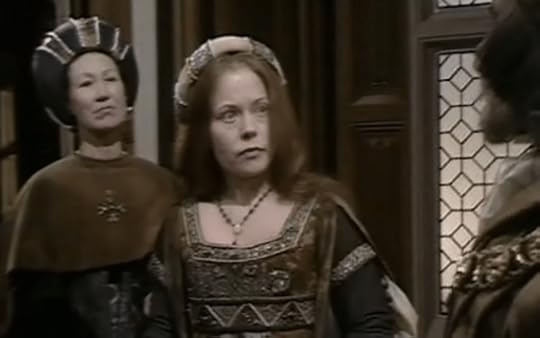 Catherine complains of her poor treatment as portrayed by Annette Crosbie in The Six Wives of Henry VIII (1970)(Screenshot/Fair Use)
Catherine complains of her poor treatment as portrayed by Annette Crosbie in The Six Wives of Henry VIII (1970)(Screenshot/Fair Use)In 1506, she briefly met her sister, Joanna, and her brother-in-law, Philip, who had been forced to land in England because of the storm. Catherine had not seen Joanna in ten years, and they only had a little time together. It was the last time they would see each other, and Joanna and Philip were soon back on their way to Castile. Meanwhile, her financial situation was becoming more strained. She wrote to her father, “Things here become daily worse and my life more and more unsupportable, I can no longer bear this in any manner… It is impossible for me any longer to endure what I have gone through and am still suffering from the unkindness of the King and the manner in which he treats me…”2
 Catherine and Joanna meet in England as portrayed in The Spanish Princess (2019)(Screenshot/Fair Use)
Catherine and Joanna meet in England as portrayed in The Spanish Princess (2019)(Screenshot/Fair Use)Things finally changed when King Henry VII died on 21 April 1509. Prince Henry now became King Henry VIII. Catherine was presumably at Richmond Palace when the King died there, but his death had been kept a secret for three days. In early May, the Spanish ambassador learned that the new King intended to marry Catherine and King Ferdinand wrote that he was thankful to hear of it as he loved Catherine “more than any of his other children.”3
Catherine and Henry were married at Greenwich on 11 June 1509, and she finally became Queen of England. In stark contrast with her first wedding night, there was no doubt that this second marriage was fully consummated. On 23 June 1509, she and Henry had a joint coronation at Westminster Abbey. The celebrations continued for days, and it appeared that better days were finally coming for Catherine.
 The coronation as portrayed in The Six Wives of Henry VIII (2001)(Screenshot/Fair Use)
The coronation as portrayed in The Six Wives of Henry VIII (2001)(Screenshot/Fair Use)On 1 November, Catherine’s first pregnancy was announced to the court. King Henry wrote to his father that “the child in her womb is alive” and that he and the kingdom “rejoice at this good news.”4 At the end of January 1510, Catherine went into premature labour and gave birth to a stillborn daughter. However, her belly remained large, and one of the physicians told her she had been pregnant with twins and that she was still pregnant with the second twin. She entered confinement again in March, but the month passed with no sign of labour. By the end of May, Catherine realised there would be no second baby. However, she was already pregnant again. Because of how her first pregnancy had ended, she remained secluded at Eltham Palace. In October, she joined Henry at Greenwich, and in November, she headed to Richmond Palace for her confinement.
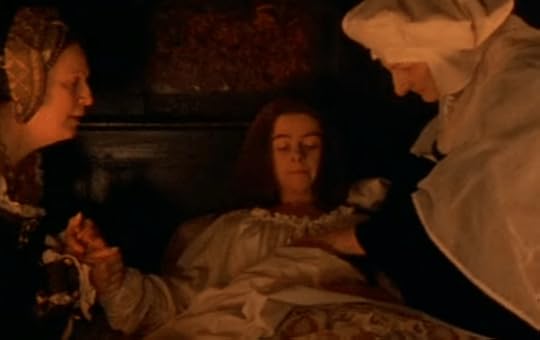 Her first pregnancy, as portrayed in The Six Wives of Henry VIII (2001)(Screenshot/Fair Use)
Her first pregnancy, as portrayed in The Six Wives of Henry VIII (2001)(Screenshot/Fair Use)On 1 January 1511, Catherine gave birth to a healthy baby boy, who was named Henry. Her husband rode to the shrine of Our Lady of Walsingham to give thanks. Their happiness was short-lived, and the little prince died on 22 February 1511. Catherine was “like a naturall woman, [she] made much lamentacioun.”5 It was not clear what caused little Henry’s death.
In 1513, King Henry was planning an invasion of France, and in June, he appointed Catherine as “Regent and Governess of England, Wales, and Ireland during the king’s absence.”6 She was four months pregnant at the time and still travelled with him to the coast as he headed to France. At the same time, King James IV of Scotland was planning to invade England. The invasion came in September, and she travelled to Buckinghamshire, where she addressed the troops. The battle took place on 9 September and King James was killed. A victorious Catherine wrote to Henry, “My Lord Howard hath sent me a letter, open, to your Grace, within one of mine, by the which ye shall see at length the great victory that our Lord hath sent your subjects in your absence. Thinks the victory the great honour that could be.”7 She also sent him a piece of King James’s coat.
Sometime in September, Catherine lost her third child. This likely happened on her way home or soon after she arrived home. It was reported that she had given birth to a son, and he was given a name – Henry. This seems to suggest that he was born alive and died shortly after. Catherine and Henry were reunited at the end of October. Catherine wrote to King James’s widow, Margaret, who also happened to be her sister-in-law, and Margaret wrote back thanking her “for her sympathy in the misfortune fallen upon her.”8
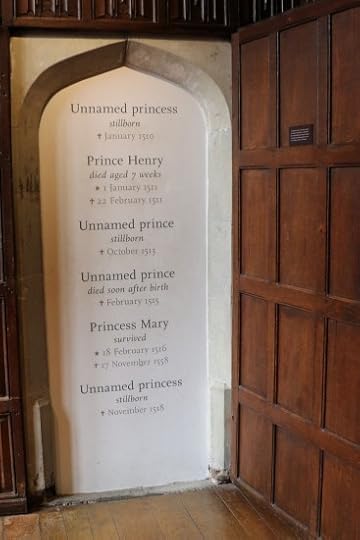 Photo by Moniek Bloks
Photo by Moniek BloksIn October 1514, King Henry’s other sister, Mary, married the 52-year-old King Louis XII of France. Catherine was already pregnant again when she waved off her sister-in-law. But she lost the child at the end of the year or early in the new year. Catherine herself wrote of losing the child after Candlemas, which fell on 2 February 1515.9 She had now lost four children in five years, which must have weighed heavy on her mind. Just four months later, she was pregnant again. In January 1515, Mary was widowed after just three months of marriage, and she secretly married Charles Brandon, who had come to fetch her home. Henry was furious when he learned of the marriage, and it wasn’t until May that the couple was forgiven and formally married in Greenwich.
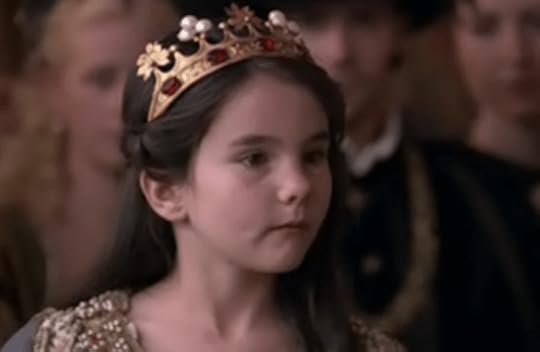 Mary as portrayed in The Tudors (2007)(Screenshot/Fair Use)
Mary as portrayed in The Tudors (2007)(Screenshot/Fair Use)At the end of January 1516, Catherine went into confinement at Greenwich. On 18 February, she gave birth to a daughter who lived – Mary. Henry was relieved at the birth of a healthy child, saying, “If it was a daughter this time, by the grace of God, the sons would follow.”10 Only after Mary’s birth was Catherine informed of her father’s death on 23 January 1516. Catherine would conceive once more in early 1518, but an outbreak of the sweating sickness threw the court into turmoil. As Catherine neared the end of her pregnancy, Henry also conceived a child with Bessie Blount. On 10 November 1518, Catherine gave birth to a stillborn or shortlived daughter. The following June, Bessie gave birth to a healthy son, who was named Henry Fitzroy. It is unclear when Catherine learned of his existence, although this was certainly at some point before 1525 when he was created Duke of Richmond and Somerset.
Part five coming soon.
The post Catherine of Aragon – Queen at last (Part four) appeared first on History of Royal Women.
The Year of Isabella I of Castile – Catherine of Aragon, Queen at last (Part four)
The following years were difficult for Catherine. Prince Henry formally renounced his betrothal to her, but it is unclear how much she knew about that. She was certainly aware that no wedding was being planned. Her household was disbanded in 1505, and she was moved from Durham House to a corner of Richmond Palace. She was soon in financial trouble as she did not receive a high enough income to have a standard of living. She wrote to the Spanish ambassador about the “misery in which she lived.”1
 Catherine complains of her poor treatment as portrayed by Annette Crosbie in The Six Wives of Henry VIII (1970)(Screenshot/Fair Use)
Catherine complains of her poor treatment as portrayed by Annette Crosbie in The Six Wives of Henry VIII (1970)(Screenshot/Fair Use)In 1506, she briefly met her sister, Joanna, and her brother-in-law, Philip, who had been forced to land in England because of the storm. Catherine had not seen Joanna in ten years, and they only had a little time together. It was the last time they would see each other, and Joanna and Philip were soon back on their way to Castile. Meanwhile, her financial situation was becoming more strained. She wrote to her father, “Things here become daily worse and my life more and more unsupportable, I can no longer bear this in any manner… It is impossible for me any longer to endure what I have gone through and am still suffering from the unkindness of the King and the manner in which he treats me…”2
 Catherine and Joanna meet in England as portrayed in The Spanish Princess (2019)(Screenshot/Fair Use)
Catherine and Joanna meet in England as portrayed in The Spanish Princess (2019)(Screenshot/Fair Use)Things finally changed when King Henry VII died on 21 April 1509. Prince Henry now became King Henry VIII. Catherine was presumably at Richmond Palace when the King died there, but his death had been kept a secret for three days. In early May, the Spanish ambassador learned that the new King intended to marry Catherine and King Ferdinand wrote that he was thankful to hear of it as he loved Catherine “more than any of his other children.”3
Catherine and Henry were married at Greenwich on 11 June 1509, and she finally became Queen of England. In stark contrast with her first wedding night, there was no doubt that this second marriage was fully consummated. On 23 June 1509, she and Henry had a joint coronation at Westminster Abbey. The celebrations continued for days, and it appeared that better days were finally coming for Catherine.
 The coronation as portrayed in The Six Wives of Henry VIII (2001)(Screenshot/Fair Use)
The coronation as portrayed in The Six Wives of Henry VIII (2001)(Screenshot/Fair Use)On 1 November, Catherine’s first pregnancy was announced to the court. King Henry wrote to his father that “the child in her womb is alive” and that he and the kingdom “rejoice at this good news.”4 At the end of January 1510, Catherine went into premature labour and gave birth to a stillborn daughter. However, her belly remained large, and one of the physicians told her she had been pregnant with twins and that she was still pregnant with the second twin. She entered confinement again in March, but the month passed with no sign of labour. By the end of May, Catherine realised there would be no second baby. However, she was already pregnant again. Because of how her first pregnancy had ended, she remained secluded at Eltham Palace. In October, she joined Henry at Greenwich, and in November, she headed to Richmond Palace for her confinement.
 Her first pregnancy, as portrayed in The Six Wives of Henry VIII (2001)(Screenshot/Fair Use)
Her first pregnancy, as portrayed in The Six Wives of Henry VIII (2001)(Screenshot/Fair Use)On 1 January 1511, Catherine gave birth to a healthy baby boy, who was named Henry. Her husband rode to the shrine of Our Lady of Walsingham to give thanks. Their happiness was short-lived, and the little prince died on 22 February 1511. Catherine was “like a naturall woman, [she] made much lamentacioun.”5 It was not clear what caused little Henry’s death.
In 1513, King Henry was planning an invasion of France, and in June, he appointed Catherine as “Regent and Governess of England, Wales, and Ireland during the king’s absence.”6 She was four months pregnant at the time and still travelled with him to the coast as he headed to France. At the same time, King James IV of Scotland was planning to invade England. The invasion came in September, and she travelled to Buckinghamshire, where she addressed the troops. The battle took place on 9 September and King James was killed. A victorious Catherine wrote to Henry, “My Lord Howard hath sent me a letter, open, to your Grace, within one of mine, by the which ye shall see at length the great victory that our Lord hath sent your subjects in your absence. Thinks the victory the great honour that could be.”7 She also sent him a piece of King James’s coat.
Sometime in September, Catherine lost her third child. This likely happened on her way home or soon after she arrived home. It was reported that she had given birth to a son, and he was given a name – Henry. This seems to suggest that he was born alive and died shortly after. Catherine and Henry were reunited at the end of October. Catherine wrote to King James’s widow, Margaret, who also happened to be her sister-in-law, and Margaret wrote back thanking her “for her sympathy in the misfortune fallen upon her.”8
 Photo by Moniek Bloks
Photo by Moniek BloksIn October 1514, King Henry’s other sister, Mary, married the 52-year-old King Louis XII of France. Catherine was already pregnant again when she waved off her sister-in-law. But she lost the child at the end of the year or early in the new year. Catherine herself wrote of losing the child after Candlemas, which fell on 2 February 1515.9 She had now lost four children in five years, which must have weighed heavy on her mind. Just four months later, she was pregnant again. In January 1515, Mary was widowed after just three months of marriage, and she secretly married Charles Brandon, who had come to fetch her home. Henry was furious when he learned of the marriage, and it wasn’t until May that the couple was forgiven and formally married in Greenwich.
 Mary as portrayed in The Tudors (2007)(Screenshot/Fair Use)
Mary as portrayed in The Tudors (2007)(Screenshot/Fair Use)At the end of January 1516, Catherine went into confinement at Greenwich. On 18 February, she gave birth to a daughter who lived – Mary. Henry was relieved at the birth of a healthy child, saying, “If it was a daughter this time, by the grace of God, the sons would follow.”10 Only after Mary’s birth was Catherine informed of her father’s death on 23 January 1516. Catherine would conceive once more in early 1518, but an outbreak of the sweating sickness threw the court into turmoil. As Catherine neared the end of her pregnancy, Henry also conceived a child with Bessie Blount. On 10 November 1518, Catherine gave birth to a stillborn or shortlived daughter. The following June, Bessie gave birth to a healthy son, who was named Henry Fitzroy. It is unclear when Catherine learned of his existence, although this was certainly at some point before 1525 when he was created Duke of Richmond and Somerset.
Part five coming soon.
The post The Year of Isabella I of Castile – Catherine of Aragon, Queen at last (Part four) appeared first on History of Royal Women.
December 22, 2024
Princess Wen Jiang – The debased Princess who had an incestuous affair with her brother
Princess Wen Jiang (also known as Princess Jiang Shi) was known as one of China’s most debased princesses.[1] She has often been depicted as “lascivious and reckless.”[2] Her incestuous affair with her brother, Duke Xiang of Qi, was said to have caused “disorder, which led to misfortune and disaster.”[3] Yet, Princess Wen Jiang was said to be a talented politician who helped maintain peace between the two States of Qi and Lu.[4]
Princess Wen Jiang was born during the Spring and Autumn period, which lasted from 771 to 453 B.C.E.[5] During this period, Chinese states were declaring their own independence from the ruling Zhou Dynasty to form their own dynasties.[6] Her first name, Wen, means “Cultured.”[7] She was a Princess of the State of Qi.[8] Her father was Duke Xi of Qi, who reigned from 730-698 B.C.E.[9] She had two known elder brothers named Prince Lu Zu’er (the future Duke Xiang of Qi from 697-686 B.C.E.) and Prince Xiaobai (who would become the future Duke Huan of Qi from 685-643 B.C.E.).[10]
Duke Xi of Qi tried to marry Princess Wen Jiang to the Crown Prince of the State of Zheng (in modern-day Henan Province).[11] This was because the State of Zheng helped the State of Qi several times.[12] However, the State of Zheng refused the marriage alliance.[13] Duke Xi of Qi eventually married Princess Wen Jiang to Duke Huan of the State of Lu (modern-day Shandong Province).[14] Thus, Princess Wen Jiang became a Duchess.[15] Three years after her marriage, Duchess Wen Jiang gave birth to a son named Tong (who would become the future Duke Zhuang of Lu from 693-662 B.C.E.).[16] She also had another son named Qingfu. Duchess Wen Jiang was said to be very powerful.[17] She travelled to other states with her husband.[18] She was often referred to as “our Minor Ruler.”[19]
In 694 B.C.E., Duchess Wen Jiang accompanied her husband, Duke Huan of Lu, back to her native homeland of the State of Qi.[20] Her brother, Lu Zu’er, was the reigning Duke Xiang of Qi. Duchess Wen Jiang then began an affair with her brother, Duke Xiang of Qi.[21] Some accounts claim that Duchess Wen Jiang had an affair with her brother before she married Duke Huan of Lu.[22] Duke Huan of Lu quickly learned of his wife’s incestuous affair.[23] Duke Xiang of Qi then held a banquet and got him drunk.[24] He ordered Prince Pengsheng to kill him.[25] Some accounts claim Prince Pengsheng was Duke Xiang’s son.[26] Others claim he was Duke Xiang’s half-brother.[27] After the assassination of Duke Huan of Lu, Duchess Wen Jiang’s son, Prince Tong, was quickly enthroned as Duke Zhuang of Lu.[28]
Duchess Wen Jiang’s whereabouts are unclear after Duke Huan of Lu’s assassination.[29] Some accounts claim that Duchess Wen Jiang remained in the State of Qi for the remainder of her life.[30] Some claim that she returned to the State of Lu with her husband’s body.[31] One source claims that her son, Duke Zhuang of Lu, built a residence for her at the Lu-Qi border.[32] Despite her whereabouts, Duchess Wen Jiang still wielded immense political power.[33] She reigned the State of Lu alongside her son and visited other states until her death in 673 B.C.E.[34] Through her efforts, she helped maintain peace between the two states, Qi and Lu.[35]
Princess Wen Jiang was infamous because of her affair with her brother, Duke Xiang of Qi.[36] It is unclear if she was responsible for the death of her husband, Duke Huan of Lu.[37] Nevertheless, she was very influential in both the reigns of her husband and son.[38] She was respected during her life and was often referred to as a “Minor Ruler.”[39] Through her efforts, she managed to foster peace between the States of Qi and Lu.[40] While she was not virtuous, Princess Wen Jiang managed to prove herself a skilled and competent politician.[41]
Sources:
Cook, C. A. (2015). “Wen Jiang, Wife of Duke Huan of Lu”. Biographical Dictionary of Chinese Women: Antiquity Through Sui, 1600 B.C.E. – 618 C.E. (L. X. H. Lee, Ed.; A. D. Stefanowska, Ed.; S. Wiles, Ed.). NY: Routledge. pp. 80-81.
Eno, R. (2010). 1.7. Spring and Autumn China (771-453). Indiana University, PDF.
Liu, X., Kinney, A. B. (2014). Exemplary Women of Early China: The Lienü Zhuan of Liu Xiang. United Kingdom: Columbia University Press.
[1] Liu & Kinney, 2014
[2] Liu & Kinney, 2014, p. 141
[3] Liu & Kinney, 2014, p. 141
[4] Cook, 2015
[5] Eno, 2010
[6] Eno, 2010
[7] Liu & Kinney, 2014, p. 263
[8] Cook, 2015
[9] Liu & Kinney, 2014
[10] Liu & Kinney, 2014
[11] Cook, 2015
[12] Cook, 2015
[13] Cook, 2015
[14] Cook, 2015
[15] Cook, 2015
[16] Cook, 2015
[17] Cook, 2015
[18] Cook, 2015
[19] Cook, 2015, p. 81
[20] Cook, 2015
[21] Cook, 2015
[22] Cook, 2015
[23] Liu & Kinney, 2014
[24] Liu & Kinney, 2014
[25] Liu & Kinney, 2014
[26] Cook, 2015
[27] Cook, 2015
[28] Cook, 2015
[29] Cook, 2015
[30] Cook, 2015
[31] Cook, 2015
[32] Cook, 2015
[33] Cook, 2015
[34] Cook, 2015
[35] Cook, 2015
[36] Liu & Kinney, 2014
[37] Liu & Kinney, 2014
[38] Cook, 2015
[39] Cook, 2015, p. 81
[40] Cook, 2015
[41] Cook, 2015
The post Princess Wen Jiang – The debased Princess who had an incestuous affair with her brother appeared first on History of Royal Women.
December 21, 2024
Book News Week 52
Book News week 52 – 23 December – 29 December 2024
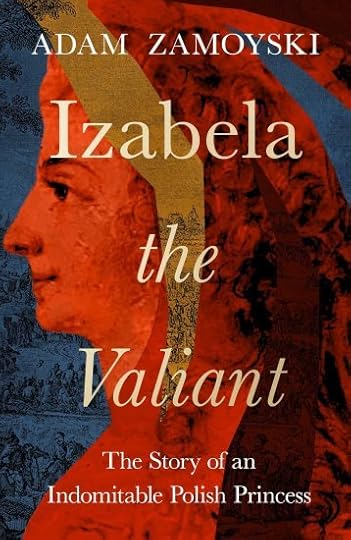
Izabela the Valiant: The Story of an Indomitable Polish Princess
Hardcover – 24 December 2024 (US)
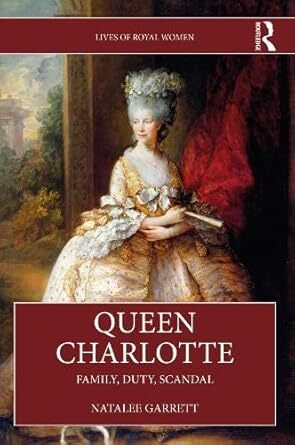
Queen Charlotte (Lives of Royal Women)
Paperback – 27 December 2024 (UK & US)
The post Book News Week 52 appeared first on History of Royal Women.
December 20, 2024
Catherine of Aragon – A bride in white (Part three)
On 14 November 1501, Catherine and Arthur finally married in person at St Paul’s Cathedral. She chose to marry in white. She wore a long white satin skirt over a farthingale (which created a hoop shape), pleated in folds. Her face was covered with a white veil with gold edges and pearls embroidered on it. She wore her hair loose, as was traditional. Her train was carried by Cecily of York, Queen Elizabeth’s sister. Arthur, too, was dressed in white satin, as was Prince Henry, who gave away the bride. Following the wedding ceremony, they were blessed, and a Mass was read before they retired.
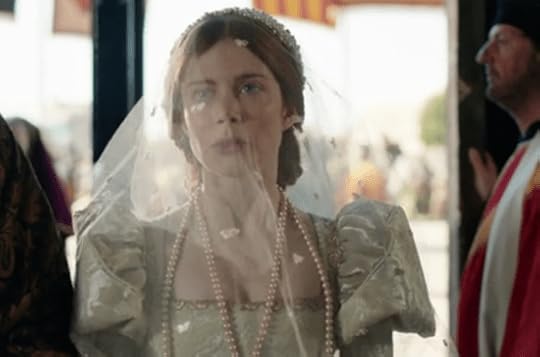 Catherine weds Arthur as portrayed in The Spanish Princess (2019)(Screenshot/Fair Use)
Catherine weds Arthur as portrayed in The Spanish Princess (2019)(Screenshot/Fair Use)In the evening, the bedding ceremony followed and many years later this night would be analysed. Catherine and Arthur travelled from the Bishop’s Palace to Baynard Castle, where the bed chamber had been prepared. Catherine was brought into the bed chamber first, dressed in her nightgown. She had to wait for Arthur, who was eventually carried in by his gentlemen. Then, everyone withdrew, leaving Catherine and Arthur alone at last. We’ll never know if consummation took place that night. Arthur bragged in the morning that he had been “in the midst of Spain” and that it was a “good pastime to have a wife.”1 Catherine later swore that it had not been consummated, and she never claimed otherwise.
On 21 December 1501, Arthur and Catherine departed for the Welsh Marches; Catherine had just celebrated her 16th birthday. At Ludlow Castle, they both had separate chambers, as was customary. Catherine settled into her new home as Arthur resumed his duties as Prince of Wales. She formed a close connection to Margaret Pole, who was the daughter of George Plantagenet, Duke of Clarence and thus a cousin of Queen Elizabeth.
At the end of March 1502, Arthur and Catherine both fell ill. It is not quite clear what they were ill with; it could have been the plague or the sweat. However, while Catherine eventually recovered, Arthur died on 2 April 1502. Following the examination of his body, a physician diagnosed “tisis”, “phthisis”, or pulmonary tuberculosis.2 However, a disease like this would have been obvious for a lot longer, and he had not been described as having been sickly before. It is not clear when Catherine finally learned the devastating news.
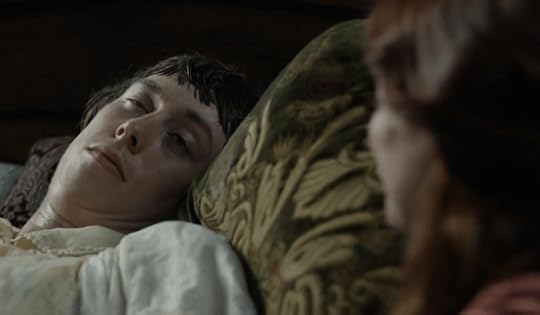 Arthur’s death as portrayed in The Spanish Princess (2019)(Screenshot/Fair Use)
Arthur’s death as portrayed in The Spanish Princess (2019)(Screenshot/Fair Use)King Henry learned the news on 5 April and immediately sent for Queen Elizabeth so that they may “take the Painefull sorrows together.”3 Within weeks, Queen Elizabeth was pregnant again for the sake of the dynasty. On 25 April, Arthur was laid to rest at Worcester Cathedral; Catherine was not present. As Catherine regained her health, she realised she was now in a precarious position. Perhaps she expected to return home to Castile, but this would have also meant returning her dowry. She had to wait and see what was to be decided for her. Catherine was transported to London in a black-draped carriage sent by her mother-in-law.
It wasn’t until early May that the news of Arthur’s death even reached Castile, and a special envoy was sent to England with instructions to demand that Catherine be sent home. However, when Queen Elizabeth died following childbirth on 11 February 1503, King Henry wanted to marry Catherine. Isabella was horrified at the idea. She wrote, “It would be a very terrible thing – one never before seen, and the mere mention of which offends the ears.”4 She told her ambassador, “If anything be said to you about it; speak of it as a thing not be endured. You must likewise say very decidedly that on no account would we allow it, or even hear it mentioned, in order that by these means, the King of England may lose all hope of bringing it to pass, if he has any. For the conclusion of the betrothal of the Princess, our daughter, with the Prince of Wales, his son, would be rendered impossible if he were to nourish any such idea.”5
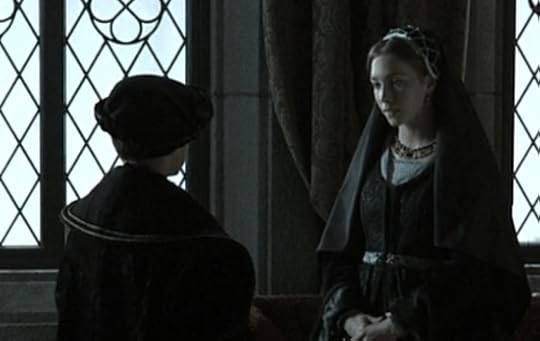 Catherine and Prince Henry shortly after Arthur’s death, as portrayed in Isabel (2011)(Screenshot/Fair Use)
Catherine and Prince Henry shortly after Arthur’s death, as portrayed in Isabel (2011)(Screenshot/Fair Use)Isabella was clearly aiming for a match with Prince Henry, and she even instructed Catherine to pack her bags to join a Spanish fleet on its way back from Flanders. This prompted King Henry to agree to a match with his other son. King Henry wrote to the Pope for the papal dispensation, which included a part about the non-consummation of her first marriage to prevent arguments over legitimacy. The wedding was set to take place when Prince Henry turned 14 in the summer of 1505, and Catherine was sent to live at Durham House. Catherine was miserable there, and she often wrote to her mother about her ill health and unhappiness. She often stopped eating, and King Henry was forced to write to the Pope to ask him to order her to eat. She was sometimes allowed to visit the court.
On 26 November 1504, Catherine’s mother, Isabella, died, and her sister Joanna became the new Queen regnant of Castile. She had written to her mother that day, not knowing that she had already passed, and had written that she had “no other hope or comfort than that which comes with knowing that her mother and father are well.”6 Catherine likely only learned of her mother’s death sometime in December. Her mother’s loss also meant a loss of status for Catherine. She no longer represented the mighty Castile, and if King Henry wanted an alliance with Castile, he would now look towards the new King and Queen. Their daughter, Eleanor, was looking far better now. The summer of 1505 passed without a wedding for Catherine and Prince Henry.
Part four coming soon.
The post Catherine of Aragon – A bride in white (Part three) appeared first on History of Royal Women.
December 19, 2024
Princess Claire’s Pearl and Diamond Tiara
Princess Claire of Belgium began wearing this pearl and diamond tiara in 2010.
Embed from Getty ImagesIts first outing was for the royal wedding of Crown Princess Victoria of Sweden and Daniel Westling. The tiara features a fleur-de-lis pattern against vertical lines topped with half-pearl buttons. She has since worn it to two more royal weddings: the wedding of Albert II, Prince of Monaco and Charlene Wittstock in 2011 and the wedding of Guillaume, Hereditary Grand Duke of Luxembourg and Countess Stéphanie de Lannoy in 2012.1
Unfortunately, we know nothing about the provenance of the tiara.
The post Princess Claire’s Pearl and Diamond Tiara appeared first on History of Royal Women.
December 18, 2024
Catherine of Aragon – “No woman could be more agreeable” (Part two)
However, she was still very malnourished from all the fasting she had done, and she died within an hour of giving birth. A historian at court wrote to the Archbishop of Braga, “The mother [Queen Isabella] was large, while the daughter [Isabella] was so consumed by her thinness that she did not have the strength to resist the birth… Scarcely had the child emerged from her uterus than the mother’s spirit was extinguished… Despite this, let’s fix it so that this tragic tale ends with a (more) musical refrain. There is compensation for so much misfortune, an important lightener to such a deep pain: she gave birth to a son.”8
Her son was named Miguel de la Paz, and he was granted Aragonese succession rights on top of the rights he had in Castile and Portugal. He was a sickly child and Manuel left him in the care of Queen Isabella while he returned to Portugal. On 19 July 1500, Queen Isabella held her young grandson as he, too, died. This left Joanna as the next heir.
Over the years, Catherine had waited for her own marriage as she watched her siblings leave. In 1497, she signed her own name to some new terms concerning her marriage contract. The formal betrothal took place at Woodstock Palace on 15 August 1497, and Catherine was represented by Ambassador de Puebla. A proxy ceremony took place on 19 May 1499 at Tickenhill Manor. Arthur “was very much rejoiced to contract with Catherine … in indissoluble marriage, not only in obedience to the Pope and King Henry but also for his deep and sincere love for the princess, his wife.”9 Meanwhile, Catherine and Arthur exchanged letters in Latin. Surprisingly, no effort was made to teach Catherine English. Following the tragic death of John, Catherine’s parents insisted on a new clause in the contract. Catherine’s dowry, which was meant to be paid ten days after the wedding, was now moved to be paid ten days after the consummation, implying that there may be some delay in the consummation. King Henry apparently suggested some compromise, where the marriage was consummated on the day of the wedding, but Arthur would then “separate himself from her for two or three years because it is said in some way the prince is frail.”10 After Arthur’s 14th birthday, a second wedding ceremony was held on 22 November 1500.
As the year 1501 began, Catherine’s departure was now being carefully prepared. Her elaborate trousseau consisted of skirts, veils, brocades and laces. Isabella also packed a christening gown for her future grandchildren. Catherine was to be accompanied by 150 people, but King Henry objected to the size of the entourage and gave a list of 20 positions that should be filled. He also requested that her ladies should be “of gentle birth and beautiful or, at the least, by no means ugly.”11
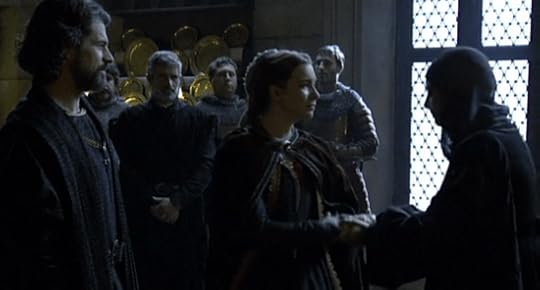 Catherine says goodbye to her mother as portrayed in Isabel (2011)(Screenshot/Fair Use)
Catherine says goodbye to her mother as portrayed in Isabel (2011)(Screenshot/Fair Use)On 21 May 1501, Catherine left the Alhambra with a household of 55. Her mother was already in “ill health”, and they said their farewells in Granada.12 They would never see each other again. Isabella had written to King Henry, asking him to treat her “as their true daughter.” 13 Catherine set sail from Corunna, and they spent six weeks making the dangerous crossing. Early on, they were hit by a storm, and one of the ships was lost to the sea. She arrived at Plymouth on 2 October 1501. Her first request was to be taken to the local parish church to give thanks.
The entourage headed to Exeter the following day, which took them a couple of days. In Exeter, she received a letter from King Henry in which he requested that she regard him “henceforth as your good and loving father, as familiarly as you would do the king and queen your parents, for on our part we are determined to treat, receive and favour you like our own daughter, and in no wise more, or less dearly, than any of our own children.”14 As Catherine headed to London, King Henry rode to meet her. At the same time, Arthur departed from Ludlow Castle. They met her at Dogmersfield House on 6 November, where they surprised her Spanish entourage. They were under strict instructions that Catherine should have no “manner of communication or company with Prince Arthur or his family, or to be seen unveiled, until the morning of the wedding day.”15
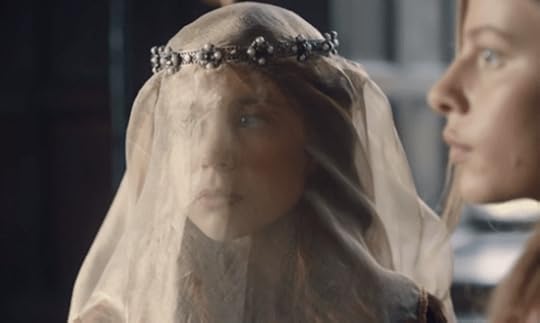 Charlotte Hope as Catherine in The Spanish Princess (2019)(Screenshot/Fair Use)
Charlotte Hope as Catherine in The Spanish Princess (2019)(Screenshot/Fair Use)King Henry insisted on seeing Catherine, finding that the Spanish customs had no jurisdiction in England. Catherine found it more diplomatic to see him and asked only for a little time to prepare herself. He was pleased with her and considered it an “honourable meeting.”16 He quickly brought Arthur to meet her, and they finally met face to face after years of writing to each other in Latin. Communication proved difficult; she spoke no English, Henry and Arthur spoke no Spanish, and they found that they had different pronunciations of Latin. Arthur would later write to Catherine’s parents that he had “never felt so much joy” as when he “beheld the sweet face of his bride” and that “no woman in the world could be more agreeable to him.”17
The following day, King Henry and Arthur left for London and Catherine followed behind slowly. On 12 November, they arrived at Lambeth Palace. That day, she would also meet her second husband, Arthur’s brother Henry. Slowly, Catherine proceeded from St George’s Field to London Bridge. Her entry into the city had been planned long before, and she was joyously welcomed with pageants and other festivities. On the 13th, Catherine finally met her mother-in-law, Elizabeth of York.
The post Catherine of Aragon – “No woman could be more agreeable” (Part two) appeared first on History of Royal Women.
The Year of Isabella I of Castile – Catherine of Aragon, “No woman could be more agreeable” (Part two)
However, she was still very malnourished from all the fasting she had done, and she died within an hour of giving birth. A historian at court wrote to the Archbishop of Braga, “The mother [Queen Isabella] was large, while the daughter [Isabella] was so consumed by her thinness that she did not have the strength to resist the birth… Scarcely had the child emerged from her uterus than the mother’s spirit was extinguished… Despite this, let’s fix it so that this tragic tale ends with a (more) musical refrain. There is compensation for so much misfortune, an important lightener to such a deep pain: she gave birth to a son.”1
Her son was named Miguel de la Paz, and he was granted Aragonese succession rights on top of the rights he had in Castile and Portugal. He was a sickly child and Manuel left him in the care of Queen Isabella while he returned to Portugal. On 19 July 1500, Queen Isabella held her young grandson as he, too, died. This left Joanna as the next heir.
Over the years, Catherine had waited for her own marriage as she watched her siblings leave. In 1497, she signed her own name to some new terms concerning her marriage contract. The formal betrothal took place at Woodstock Palace on 15 August 1497, and Catherine was represented by Ambassador de Puebla. A proxy ceremony took place on 19 May 1499 at Tickenhill Manor. Arthur “was very much rejoiced to contract with Catherine … in indissoluble marriage, not only in obedience to the Pope and King Henry but also for his deep and sincere love for the princess, his wife.”2 Meanwhile, Catherine and Arthur exchanged letters in Latin. Surprisingly, no effort was made to teach Catherine English. Following the tragic death of John, Catherine’s parents insisted on a new clause in the contract. Catherine’s dowry, which was meant to be paid ten days after the wedding, was now moved to be paid ten days after the consummation, implying that there may be some delay in the consummation. King Henry apparently suggested some compromise, where the marriage was consummated on the day of the wedding, but Arthur would then “separate himself from her for two or three years because it is said in some way the prince is frail.”3 After Arthur’s 14th birthday, a second wedding ceremony was held on 22 November 1500.
As the year 1501 began, Catherine’s departure was now being carefully prepared. Her elaborate trousseau consisted of skirts, veils, brocades and laces. Isabella also packed a christening gown for her future grandchildren. Catherine was to be accompanied by 150 people, but King Henry objected to the size of the entourage and gave a list of 20 positions that should be filled. He also requested that her ladies should be “of gentle birth and beautiful or, at the least, by no means ugly.”4
 Catherine says goodbye to her mother as portrayed in Isabel (2011)(Screenshot/Fair Use)
Catherine says goodbye to her mother as portrayed in Isabel (2011)(Screenshot/Fair Use)On 21 May 1501, Catherine left the Alhambra with a household of 55. Her mother was already in “ill health”, and they said their farewells in Granada.5 They would never see each other again. Isabella had written to King Henry, asking him to treat her “as their true daughter.” 6 Catherine set sail from Corunna, and they spent six weeks making the dangerous crossing. Early on, they were hit by a storm, and one of the ships was lost to the sea. She arrived at Plymouth on 2 October 1501. Her first request was to be taken to the local parish church to give thanks.
The entourage headed to Exeter the following day, which took them a couple of days. In Exeter, she received a letter from King Henry in which he requested that she regard him “henceforth as your good and loving father, as familiarly as you would do the king and queen your parents, for on our part we are determined to treat, receive and favour you like our own daughter, and in no wise more, or less dearly, than any of our own children.”7 As Catherine headed to London, King Henry rode to meet her. At the same time, Arthur departed from Ludlow Castle. They met her at Dogmersfield House on 6 November, where they surprised her Spanish entourage. They were under strict instructions that Catherine should have no “manner of communication or company with Prince Arthur or his family, or to be seen unveiled, until the morning of the wedding day.”8
 Charlotte Hope as Catherine in The Spanish Princess (2019)(Screenshot/Fair Use)
Charlotte Hope as Catherine in The Spanish Princess (2019)(Screenshot/Fair Use)King Henry insisted on seeing Catherine, finding that the Spanish customs had no jurisdiction in England. Catherine found it more diplomatic to see him and asked only for a little time to prepare herself. He was pleased with her and considered it an “honourable meeting.”9 He quickly brought Arthur to meet her, and they finally met face to face after years of writing to each other in Latin. Communication proved difficult; she spoke no English, Henry and Arthur spoke no Spanish, and they found that they had different pronunciations of Latin. Arthur would later write to Catherine’s parents that he had “never felt so much joy” as when he “beheld the sweet face of his bride” and that “no woman in the world could be more agreeable to him.”10
The following day, King Henry and Arthur left for London and Catherine followed behind slowly. On 12 November, they arrived at Lambeth Palace. That day, she would also meet her second husband, Arthur’s brother Henry. Slowly, Catherine proceeded from St George’s Field to London Bridge. Her entry into the city had been planned long before, and she was joyously welcomed with pageants and other festivities. On the 13th, Catherine finally met her mother-in-law, Elizabeth of York.
Part three coming soon.
The post The Year of Isabella I of Castile – Catherine of Aragon, “No woman could be more agreeable” (Part two) appeared first on History of Royal Women.
December 17, 2024
Queen Isabella I of Castile’s final resting place
On 26 November 1504, Queen Isabella I of Castile died at the age of 53.
Her husband, King Ferdinand II of Aragon, announced her death to the waiting public and sent messengers across the country with the news. On a hastily erected stand, the Duke of Alba raised Queen Isabella’s banner three times while announcing, “Castile, Castile for our Sovereign Lady, Queen Juana [Joanna].”1 In Joanna’s absence, Ferdinand assumed the title of regent, and he received homage from the nobles.
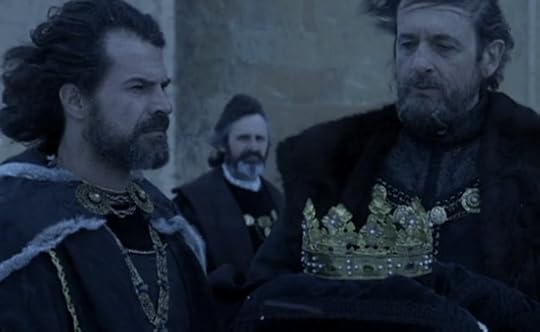 Ferdinand announces Isabella’s death as portrayed in Isabel (2011)(Screenshot/Fair Use)
Ferdinand announces Isabella’s death as portrayed in Isabel (2011)(Screenshot/Fair Use)Isabella’s body was not embalmed, and she was dressed in a Franciscan habit. The following morning, Ferdinand and the mourning procession followed the coffin south to Granada. In the following three weeks, the cortege was battered by storms as it passed Isabella’s childhood home and several other cities. On 18 December 1504, the mourners reached Granada.
Isabella’s coffin, draped in black velvet, would wait for 17 years in the Franciscan monastery for the completion of the new Chapel Royal of the yet-unbuilt Cathedral of Granada. She requested to be buried with her eldest daughter, Isabella, but this request was never fulfilled, and the younger Isabella remains buried in Toledo.
Embed from Getty ImagesShe would eventually be joined by her husband, her successor Joanna, Joanna’s husband, Philip, and her grandson, Miguel de la Paz.
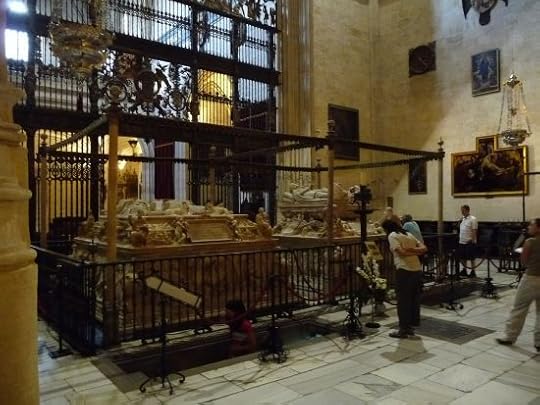 El Pantera – Own work, CC BY-SA 4.0 via Wikimedia Commons
El Pantera – Own work, CC BY-SA 4.0 via Wikimedia CommonsThe post Queen Isabella I of Castile’s final resting place appeared first on History of Royal Women.
December 16, 2024
Christina of Denmark – Beloved by all (Part five)
The year 1558 was undoubtedly the end of an era with the deaths of Christina’s uncle, Charles V, Holy Roman Emperor, and her aunts, Eleanor and Mary. In that sense, 1559 was a new beginning with the wedding of her son, Charles, to Princess Claude. On 22 January 1559, they were married at the Notre Dame. However, Christina declined to attend due to her deep mourning and her promise to be present at a peace conference.
In May 1559, Christina was able to return to Brussels with her daughters. She perhaps expected to be appointed as governor of the Habsburg Netherlands, but Margaret of Parma, the illegitimate daughter of Emperor Charles, was chosen instead. One observer wrote, “There is great discontent here at the Duchess of Parma’s appointment. The common folk use very insolent language and say that if a woman is to reign over them, they would far rather have the Duchess of Lorraine, whom they know and love and hold to be one of themselves. Everyone, indeed, would have greatly preferred this Princess, who is of royal lineage on both sides and has long dwelt in these provinces, besides being far more gracious and affable to the nobles.”1 Christina was disappointed in King Philip’s decision and felt she deserved more, especially after all she had done at the peace conference.
Christina decided to return to Lorraine. During this time, marriage negotiations were underway between her eldest daughter. Renata, and the Prince of Orange, William. However, this match was sabotaged by King Philip and did not take place. She returned to Lorraine just as King Henry II was fatally wounded during a joust. The new King was his son, Francis II, who was married to Mary, Queen of Scots. Christina’s son Charles had grown up with them and knew them well. Christina settled into her old rooms at Nancy’s ducal palace, and as her son returned to the French court, she was left in charge as regent. On 5 December 1560, King Francis II suddenly died, leaving his ten-year-old brother, Charles IX, as the next King. Christina hosted the widowed Mary, Queen of Scots, at Nancy before celebrating the new King’s coronation.
In 1561, Christina’s father died in prison in Denmark, and her sister Dorothea assumed the title of Queen of Denmark, although it was an empty title. Christina reportedly visited her sister to convince her to pass her claim to her nephew, Christina’s son. Danish exiled flocked to Lorraine, which revived Christina’s dreams of recovering her father’s kingdoms. In any case, Lorraine remained her top priority. Charles often consulted her on state matters, and he treated her with respect.
On 8 November 1563, Christina became a grandmother for the first time. Her daughter-in-law, Claude, gave birth to a son named Henry. Both King Charles IX of France and King Philip II of Spain agreed to be godfathers. He was finally baptised on 2 May 1564 as Christina held him at the font. The following year, Christina was suffering from a “grave internal malady.”2 She relapsed again in November, and her life was considered to be in danger. Luckily, she recovered her health. In the following years, Christina tried to press her claims on Denmark, but in the end, it was no use.
Christina’s delight during these difficult years was her son’s growing family. Her eldest granddaughter carried her name and was also most like her. On 22 February 1568, her eldest daughter Renata married the future William V, Duke of Bavaria, while her youngest daughter Dorothea married Eric II, Duke of Brunswick-Lüneburg, in 1575. However, her health was troubling her, and upon the advice of her doctor, she decided to seek a warmer climate, and she moved to her dower city – Tortona – in June 1579. One chronicler wrote, “The Duchess Christina of Milan celebrated for her beauty and gracious manners, for her affability and generosity, has lately come to spend her widowhood in the city of Tortona, and lives there in great splendour, beloved by all.”3
Her life at Tortona was peaceful, although she never did escape the news from the outside world. She learned of the assassination of the Prince of Orange in 1584, the execution of Mary, Queen of Scots, in 1587 and the assassination of the Duke of Guise in 1588.
In the summer of 1590, she and her daughter Dorothea travelled to the Rocca of Sparaviera, but she fell ill while there. She tried to return home and travelled by water but only made it to Alessandria. She died there on 10 December 1590 in the house of her friend, Maddalena Guasco. However, one source states she died on 10 August.4 She was 69 years old.
The post Christina of Denmark – Beloved by all (Part five) appeared first on History of Royal Women.



